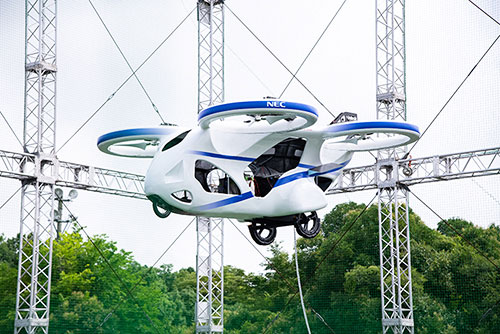News
The Car Really Took Off! Updated in March 2020
At the end of January 2019, the website JST Japan Window published an article titled “If Cars Could Fly in the Sky” in its Scientific Research column. The article introduced the Roadmap for Air Mobility Revolution, led by Japan’s Ministry of Economy, Trade and Industry (METI) and the Ministry of Land, Infrastructure, Transport and Tourism (MLIT). Bringing the dream of flying vehicles to life has been undertaken by the Public-Private Conference for Future Air Mobility, including members from the University of Tokyo, Japan Aerospace Exploration Agency (JAXA), Subaru, Japan Airlines, NEC, and others.
The article stated that “Japan has lagged behind world's pioneers in the field of air vehicles. Current leading players are Uber (United States), Airbus (France), and Volocopter (Germany).” Just six months after the article was published, however, a flying car really did take off in Tokyo! Although a test model, NEC unveiled its flying car on August 5, 2019, to much surprise.

NEC Tests the Sky with Its Flying Car
According to NEC, the company has a set of communications technology platform plans laid out for the flying vehicle. This is an indispensable traffic control platform covering inter-airframe, and airframe-ground communication management. The body size of the flying car released last summer is 3.9 meters (length) x 3.7 meters (width) x 1.3 meters (height). This test model is the first stage of the development plan, and will be used to collect data related to the car-body management functions and flight characteristics.
NEC, formerly known as Nippon Denki or Nippon Electric Company is a well-known high-tech Japanese IT giant. Its communication products were renowned in the past, but now the company is well-known for face-recognition technology, artificial intelligence, and rechargeable batteries. So why did the IT company suddenly turn to the development of flying cars?
There is a civilian group in Japan that promotes the research and development of flying cars, called CARTIVATOR. CARTIVATOR consists of young volunteers from the automotive/aviation industries and related startups. It has 36 sponsors, largest among them, Toyota Motors. Other car companies like Daihatsu Industries and Hino Motors also participated in the sponsorship. Together with Japan’s flying vehicle startup SKYDRIVE, CARTIVATOR conducted unmanned vehicle flight tests in September 2018, and has recently been planning manned vehicle tests. The group also plans to conduct a demonstration to ignite the Tokyo Olympic torch flame in July, 2020. It will start marketing manned vehicles in 2023 and is scheduled to achieve mass production of manned vehicles in 2026.
The purpose of NEC's prototype machine is not for testing the actual car-body, but for testing the communication technology between the car-body and its surrounding environment. This trial model is more of a large drone than a true flying car. NEC is a telecommunications manufacturer. It has rich technical experience in aviation control systems, satellite application systems, and drone control technologies in the aerospace field. Thus, accumulation of such communication technologies now used for air vehicles was a natural course for NEC. Moreover, it also proves that there are no more puzzles in modern automotive and mechanical movement. Thus, there are less barriers for newcomers to produce different types of automobiles. All the while, figuring out IT technology has become increasingly important in the age of artificial intelligence.
Toyota on the other hand has not launched its own flying car yet. It merely supports CARTIVATOR and the SKYDRIVE project. The European Aero Mobil company announced a flying car at the International Motor Show in Frankfurt, Germany as early as 2017. It shows that Japan still needs to make a technological breakthrough in terms of air suspension. It seems that the key technologies of this field are still in the hands of its European and American counterparts.
In addition to technical thresholds, there are also legal restrictions on whether the flying car can really “fly” as planned. Compared to automobiles running on the ground, there are no corresponding aerial standards and regulations in terms of noise, safety, and operation rules for flying cars—it’s a blank slate so far. Issues remain whether the mass consumer will ultimately accept flying cars, how competitive they can be in comparison with existing means of transportation, whether the market can really accommodate them, etc. Obviously, there are still many issues. As a mature developed country, Japan has a large number of laws and regulations. Clearing constraints of vested interest groups and immediately establishing a set of regulations and laws corresponding to flying cars would seem to be a formidable challenge. Japan’s government-civilian cooperation to promote flying cars seems to focus on exports. That is, how to turn Japan’s advanced technology into products intended for export overseas.
From this perspective, NEC has foresight. Since Internet technology has replaced traditional communication technologies, this century-old communications manufacturer has been struggling to survive, just like other big Japanese corporations. However, after experiencing the pains of transformation, NEC has moved onto the field of information systems to open up the large rechargeable battery market. It has since made a breakthrough in the field of new energy, which includes solar power generation. NEC's face-recognition technology has also been adopted in Europe and China. In the field of aerial control, NEC’s endeavor is worthy of praise. (859 words)
Contributed by DAI Wei
Editorial modification by JST Japan Window Editorial Office







